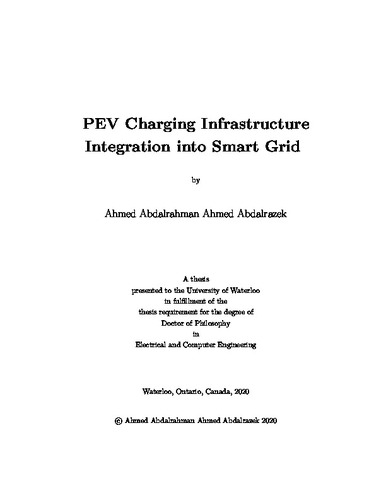| dc.description.abstract | Plug-in electric vehicles (PEVs) represent a huge step forward in a green transportation system, contribute to the reduction of greenhouse gas emission, and reduce the dependence on fossil fuel. With the increasing popularity of PEVs, public electric-vehicle charging infrastructure (EVCI) becomes indispensable to meet the PEV user requirements. EVCI can consist of various types of charging technologies, offering multiple charging services for PEV users. Proper integration of the charging infrastructure into smart grid is key to promote widespread adoption of PEVs. Planning and operation of EVCI are technically challenging, since PEVs are characterized by their limited driving range, long charging duration, and high charging power, in addition to the randomness in driving patterns and charging decisions of PEV users. EVCI planning involves both the siting and capacity planning of charging facilities. Charging facility siting must ensure not only a satisfactory charging service for PEV users but also a high utilization and profitability for the chosen facility locations. Thus, the various types of charging facilities should be located based on an accurate location estimation of the potential PEV charging demand. Capacity planning of charging facilities must ensure a satisfactory charging service for PEV users in addition to a reliable operation of the power grid. During the operation of EVCI, price-based coordination mechanisms can be leveraged to dynamically preserve the quality-of-service (QoS) requirements of charging facilities and ensure the profitability of the charging service. This research is to investigate and develop solutions for integrating the EVCI into the smart grid. It consists of three research topics:
First, we investigate PEV charging infrastructure siting. We propose a spatial-temporal flow capturing location model. This model determines the locations of various types of charging facilities based on the spatial-temporal distribution of traffic flows. In the proposed model, we consider transportation network dynamics and congestion, in addition to different characteristics and usage patterns of each charging facility type.
Second, we propose a QoS aware capacity planning of EVCI. The proposed framework accounts for the link between the charging QoS and the power distribution network (PDN) capability. Towards this end, we firstly optimize charging facility sizes to achieve a targeted QoS level. Then, we minimize the integration cost for the PDN by attaining the most cost-effective allocation of the energy storage systems and/or upgrading the PDN substation and feeders. Additionally, we capture the correlation between the occupation levels of neighboring charging facilities and the blocked PEV user behaviors.
Lastly, we investigate the coordination of PEV charging demands. We develop a differentiated pricing mechanism for a multiservice EVCI using deep reinforcement learning (RL). The proposed framework enhances the performance of charging facilities by motivating PEV users to avoid over-usage of particular service classes. Since customer-side information is stochastic, non-stationary, and expensive to collect at scale, the proposed pricing mechanism utilizes the model-free deep RL approach. In the proposed RL approach, deep neural networks are trained to determine a pricing policy while interacting with the dynamically changing environment. The neural networks take the current EVCI state as input and generate pricing signals that coordinate the anticipated PEV charging demand. | en |

